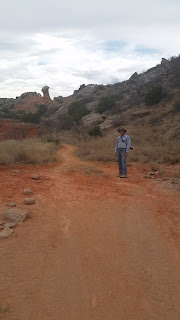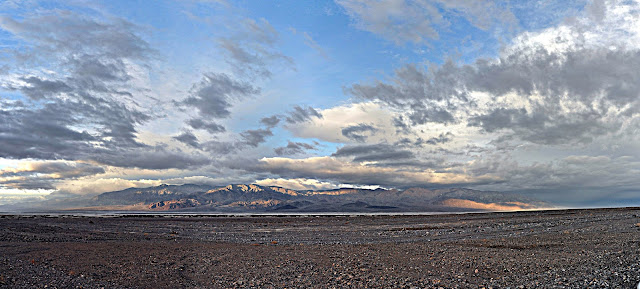Despite our promise to keep moving slowly and take one month to travel, once the decision to return home was made, it was a difficult promise to keep. Like the horse heading back to the stable, we were excited return to our beautiful home and welcome spring's arrival to Massachusetts.
 |
| We don't see too many Airstreams while traveling |
I have a cousin who lives just outside of Phoenix. Phoenix has been a mandatory stop on our southwest adventure not only because of the beautiful Lost Dutchman State Park (see our blog entry here:****), but also to visit my cousin and her mother, my aunt who passed away earlier this year). Because we bypassed Phoenix on way west and not wanting to leave Arizona without visiting my cousin we did a long day's (for us) drive from Anza Borrego Desert State Park to Goodyear, Arizona.
We stayed at the county park in Goodyear in the overflow area because the regular sites were all taken. Situated in a couple of large, gravel paved parking lots, the overflow area was actually very attractive. We especially like the elevation that afforded us a great view overlooking the city. Sarah and I enjoyed a nice dinner with my cousin, Lynn, and her partner, Tom.
With this being our third trip to the southwest, it was difficult to find routes that we had not traveled before. There are only a few roads available in this vast and rugged terrain, but we were able to connect a few stretches of scenic roads allowing us to see new territory. From Phoenix we took US 60 through Globe then on to Show Low, a town we have stayed in before. This time, we stayed at the Scott Reservoir Campground just 7 miles south of Show Low on Penrod Rd. The camping season had just begun the day we arrived. Sadly, the place was a mess with trash everywhere. Clearly, the campground had been used by people from the area as a 'party' destination. But, we just needed a place for the night, and even with the trash, it was superior to staying in a Walmart parking lot.
Continuing 145 miles east the next day took us through beautiful mountains where there was still a little snow persisting on the northern slopes of the mountains and beneath the evergreen trees. We stopped at Pie Town to buy, you guessed it, pie. This little town, sitting on the Continental Divide, has several shops offering home made pies for sale. We chose a little settler's log cabin, set back from the road that had a small sign advertising pies. The Pie Source is in the cabin. Cyndi serves coffee and and soups in addition to her fine pies. In front of the cabin are a number of interesting antique windmills decorating the yard.
From Pie Town it was a short drive to Datil Well campground where, like in Show Low, the campground had just opened for the season. Unlike Show Low, however, this campground was immaculate. We were only one of two rigs in the campground. Since it was so early, and the chance of a hard freeze remained, we had to dry camp as the water and power had not yet been turned on. We didn't mind at all because the recreation area had a nice hiking trail that wound around and to the top of a nearby hill rewarding us with wonderful views from the Datil Mountains across the Plains of San Agustin to the Gallinas Mountains to the northeast. On our hike, we saw lots of sign of elk, but we didn't see any on the hoof.
Keeping our eagerness to get home in check, we drove only about 160 miles today. Our route took us through the town of Capitan where Smokey the Bear is buried. His grave is in the garden adjacent to a small museum dedicated to him and forest fire fighting. We had visited the museum and Smokey's grave a couple years ago.
Our destination was the Rob Jaggers Campsite at Fort Stanton Snowy River Cave recreation area that is run by the BLM. Located just a short distance southeast of Capitan, the campground is in an open field that is clearly set up for the convenience of horse owners to camp and trail ride with their steeds. Once again, because it was so early in the season, except for two horseback riders, one other camper and the full time caretaker, we had the place to ourselves. It wasn't until I was writing this post that I learned of petroglyphs in the park. We will definitely need to return here.
From Fort Stanton we continued east on US 82/380 through Roswell, New Mexico to Brownfield, Texas where we turned north on US 62/385 toward Lubbock, Texas. Northwestern Texas does not have as much public land as other parts of the state. To get to a state park from Fort Stanton would have required well over 300 miles, a distance we were unwilling to do in one day. We also needed an oil change for the truck, so we chose to stop in Lubbock. We mistakenly confused a private resort on a man made lake for a county or state run facility. We pulled into the Buffalo Springs Resort which is a community of private homes with a campground. Like too many campgrounds that are in close proximity to urban areas we were disappointed by the unkempt nature of the facility and the rowdiness of the campers who used the campground as place to escape and party. The grounds were bare dirt and the 'roads' were indistinguishable from the rest of the area. We had an early morning appointment for the oil change for the next day then enjoyed visiting the Buddy Holly museum that afternoon and departed the next morning bound for Palo Duro Canyon State Park.
Since the drive from Buffalo Springs to Palo Duro was only about 125 miles, we put the GPS into "avoid highways" mode. Still, it wanted to send us onto Interstate 27. I had picked up a detailed map of the state and used it to determine our route. Based on all of our previous experiences with the roads in Texas, I felt confident towing the Mary Joan on county and "Farm to Market" roads. This day, however, that was a mistake. In this part of Northwest Texas, unlike everyplace else, these roads began as paved roads but turned to washboard gravel roads after we had committed some hours of driving on them and it was too late to turn back. We were forced to slow down to 10 mph to travel without inflicting damage to the trailer.
Because we drove so slowly, we arrived at Palo Duro Canyon State Park in the early afternoon. By the time we arrived, all of the walk up (camp sites that cannot be reserved) were gone and the campground was filled which was not surprising because it was the week of spring break. Luckily, just outside the park entrance was a private campground that had plenty of spaces. We quickly settled in then drove into the park to hike within the second largest canyon in the United States. While most of the canyon is private land, Texas has preserved a spectacularly beautiful section. Besides the beauty of the canyon, it boasts some of the finest example of cap rocks. These hard igneous rocks that overlay softer sedimentary rock stand atop the pillars that were created due to the protection the harder rock provides for the softer rock below resulting in pillars of rock with 'hats' on top.
 |
| Palo Duro Canyon |
Another canyon would be our home for the next night. We left early because we had 250 miles to reach Red Rock Canyon State Park in Oklahoma about 40 miles west of Oklahoma city. This place was also quiet this early in the season. The park is in a narrow canyon formed by soft red sandstone from which the park gets its name. It is obviously a summer getaway place for people from the Oklahoma city area. It has a swimming pool and numerous places where people can set up ropes fixed to the top of the canyons walls and rappel down into the canyon.
Concerns about the weather was now on our minds. We were now in tornado alley and the reports were calling for severe weather the next day. We decided to be on the road at daylight and move as quickly as possible across the rest of Oklahoma and all of Arkansas to reach Memphis. Hopefully, this 650 mile day will stand as record that we will never break. We endured the day by promising to spend a few days in Memphis and enjoy the music and food the city is famous for. While still subject to severe weather, we believed it would be safer to put Oklahoma and Arkansas behind us and rest up in Memphis. Our decision proved timely since severe thunderstorms with hail were just behind us as we raced east toward Tennessee.
We found Meeman-Shelby State Park just 20 minutes north of Memphis to be a convenient base from which to enjoy Memphis. The storms that followed us from Oklahoma delivered heavy rains for each of the three days we spent at Meeman-Shelby, but since we were exploring a city and not hiking we didn't mind. During our stay we visited the Metals Museum, the Gibson guitar factory and of course , Graceland. Each evening we enjoyed the food and music at one of the many venues on Beale Street.
 |
| Good music on Beale St. |
 |
 |
| Balcony where Reverend Dr. Martin Luther King was assassinated |
Keeping our promise to not rush, we set our sights on the Land Between the Lakes on the Tennessee and Kentucky border. The most direct route US 70/79, a distance of only 155 miles, but we decided to take the more scenic US51 north to Dyersburg, TN then east on TN104 where we joined US 70/79. The Land Between the Lakes is a 5 mile wide peninsula running approximately 75 miles north and south bounded by the Tennessee River on the west and Lake Barkley on the east. The entire peninsula is the Land Between the Lakes National Recreation Area with numerous campgrounds along the entire length. We stayed at Piney Campground. With 384 campsites, it is the largest campground we have ever stayed at. Almost all campsites have a view of the water, ours was directly overlooking the magnificent Tennessee River.
Traveling northward in the late winter it can be difficult to find campgrounds that are open in state or national parks. That was the case after leaving Tennessee. The Twin Knobs Campground on Cave Run Lake in the Daniel Boone National Forest wasn't scheduled to open until March 15, but it was only March 14. However, there is a large parking lot at the boat launch where boondocked for the night.
Some state parks in Pennsylvania are open all year and Lackawanna State Park, a perfect distance for the next days drive to the northeast is one of them. Once we are so near to home, we are less interested in scenic destination than the desire to back in our home. Therefore, we don't have much to say, or even remember about some of these stopovers. I note is so that we will remember the next time we are just passing through.
We left Anza Borrego Desert State Park on February 28 and arrived home on March 16, a journey of over 3,000 miles. Stay tuned for more.


























